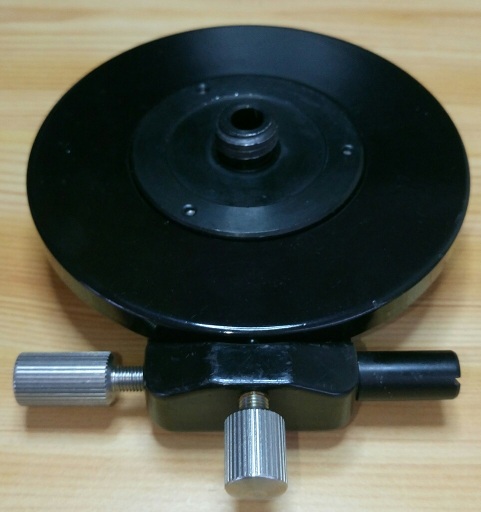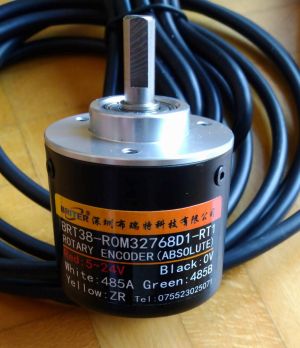Azimuth & elevation system for mobile use
1. Azimuth system
At higher frequencies and with bigger dishes -3dB beam width gets smaller and smaller. E.g. for 76GHz with a 60cm dish it is around 0.6°.
Therefore a stable azimuth system with fine adjustment is essential.
1st version:
Dish rotation was done manually by hand without any fine adjustment system.
2nd version:
Not stable enough and without azimuth scale. Coarse (0-360°) and fine adjustment (+/- 5°). One screw rotation is approx. 0.75°.

3rd version:
With coarse (0-360°) and fine adjustment (+/- 5°). One screw rotation is approx. 0.50° and azimuth angle resolution is approx. 0.01°. Now with an azimuth scale to read angle and it is very stable. Max. load should only be 50N (5 kg).



4th version:
The SEMR160-AR is the bigger brother of 3rd version with a diameter of 160 mm. Big advantage is that the load could be up to 390 N (max 39 kg), but it is heavier (2.2 kg).


2. Elevation system
At higher frequencies and with bigger dishes -3dB beam width gets smaller and smaller. E.g. for 76GHz with a 60cm dish it is approx. 0.6°.
Therefore a stable elevation system with fine adjustment is essential.
1st version:
Backslash was not small enough, not stable enough and elevation scale was only roughly.

2nd version:
Backslash was better but not small enough. It has a fine tuning screw with scale (0.1° accuracy).

3rd version:
Stable spindle system with digital tilt meter (0.1 accuracy). One spindle rotation is approx. 1.5° and therefore elevation angle resolution is down to 0.02°.

3. Manual azimuth-elevation system
Old 2nd version for my tripod:
Resolution azimuth: 0.025°
Resolution elevation: 0.1°

Finished 3rd version for my tripod:
Resolution azimuth: 0.01°, 0.45°/screw rotation
Resolution elevation: 0.02°, 1.5°/screw rotation

Finished 4th version for my tripod:
Now for a heavier load
Resolution azimuth: 0.01°, 0.45°/screw rotation
Resolution elevation: 0.02°, 1.5°/screw rotation

4. Motorized azimuth-elevation system
For EME or sun/moon noise measurements a stable and accurate tracking system is a great help.
1st version:
See more here

2nd version:
This version is an update of version 1. It is based on version 3 of my manual system but uses a worm gear DC motor for azimuth (+ encoder) and an actuator DC motor for elevation (+ inclinometer). It is more stable and in future I will use a new controller system.


5. High accuracy, motorized azimuth-elevation system for EME at higher frequencies
At higher frequencies (>24 GHz) and/or bigger dishes the half-power-beam width is around or smaller than sun/moon diameter (0.5°).
To get maximum signal level a very accurate tracking system is needed. This is very important for EME because there are 2 stations (Rx and Tx) and both stations (small antenna beams)
must meet at an exact point on the moon. EA3HMJ has developed such a high accuracy tracking system.
Power supply and current consumption: 12V or 24V, ~100 mA (only board without motor consumption)
Azimuth/elevation accuracy: <0.03°
![]()
![]()
BRT38-R0M32768-RT1 absolut-encoder with 15 bit or the waterproof 16 bit version BRT38-R0M16bit-RT1-IP68.
See here https://briterencoder.com/

SOLAR-360-2-RS485M - inclinometer sensor from level developments.
See here https://www.leveldevelopments.com/

In combination with such a DC-motor for elevation & azimuth from coresundrive.
![]()